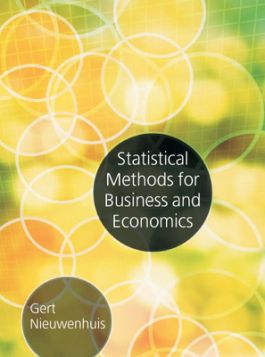Statistical Methods for Business and Economics
Receive via shipping:
- Colour, print bound version of the complete text
Detailed table of contents
Preface
Guided Tour
Technology to enhance teaching and learning
1 Introduction and basic concepts
Part 1 Descriptive Statistics
2. Tables and graphs
3. Measures of location
4. Measures of variation
5. Pairs of variables
Part 2 Probability
6. Definitions of Probability
7. Calculation of probabilities
8. Probability distribution, expectation, variance
9. Families of discrete distributions
10. Families of continuous distributions
11. Joint probability distributions
Part 3 Sampling theory
12. Random samples
13. The sample mean
14. Sample proportion and other sample statistics
Part 4 Inferential statistics
15. Interval estimation and hypothesis testing: a general introduction
16. Confidence intervals and tests for and
17. Statistical inference about
18. Confidence intervals and tests to compare two parameters
19. Simple linear regression
20. Multiple linear regression: introduction
21. Multiple linear regression: extension
22. Multiple linear regression: model violations
23. Time series and forecasting
24. Chi-squared tests
25. Nonparametric statistics
Appendix A1 Excel and SPSS (on Internet)
Appendix A2 Summation operator ?
Appendix A3 Greek letters
Appendix A4 Tables
Appendix A5 Numeric answers of exercises
Covering the essential methods required at undergraduate level, the book is structured into four parts that deal with descriptive statistics, probability, sample theory and inferential statistics, taking students from the basics through to more advanced topics such as multiple linear regression.
Every chapter contains clear descriptions of each technique, illustrated with numerous worked examples to aid students in understanding how to practice statistical methods. The real data used in the examples is drawn from European sources. The text also contains longer case examples set in a European business context, to show how statistics is used everyday in the business environment. Finally, each chapter concludes with a variety of exercises to test students’ ability to apply the theory and attain a high level of competence in using statistics.
This comprehensive book is ideal for student of statistics at undergraduate level taking an introductory module in the topic.
Supporting Websites
- Online Learning Center: http://highered.mheducation.com/sites/0077109872/information_center_view0/index.html

